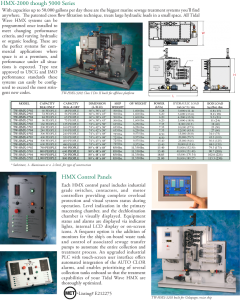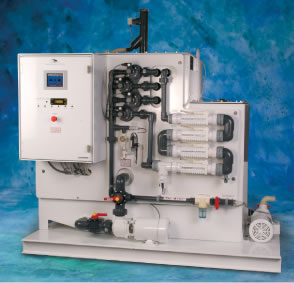HEADHUNTER Marine Sewage Treatment Systems
Headhunter’s team of engineers, fabricators, and wastewater specialists work together to provide the most innovative and efficient sewage treatment solutions. They offer in three categories STP, Physical Chemical MSD, Biological MSDs. All with standard units to custom designed units to fit our customers’ needs.
SEWAGE TREATMENT PLANT – IMO MEPC.159(55)
The TIDALWAVE HMX® Sewage Treatment Plant (STP) are IMO Approved for worldwide compliance with MEPC.159(55). Designed for quick starts and stops with the push of a button, the TIDALWAVE HMX system uses flocculent settling, chemical oxidation, hydro-maceration and patented cross flow separation techniques to thoroughly destroy influent biomass. This is all done without the need for an additional sludge retention tank onboard.
PHYSICAL CHEMICAL MARINE SANITATION DEVICE
 TIDALWAVE HMX® are U.S. Coast Guard certified Type II Marine Sanitation Devices (MSDs) in accordance with 33CFR Part 159. These systems are recommended for US Flagged vessels over 65 feet long. These systems provide automated state of the art processing of onboard sewage. Designed for quick starts and stops with the push of a button, the TIDALWAVE HMX® system uses chemical oxidation, hydro-maceration and patented cross flow separation techniques to thoroughly destroy influent biomass.
TIDALWAVE HMX® are U.S. Coast Guard certified Type II Marine Sanitation Devices (MSDs) in accordance with 33CFR Part 159. These systems are recommended for US Flagged vessels over 65 feet long. These systems provide automated state of the art processing of onboard sewage. Designed for quick starts and stops with the push of a button, the TIDALWAVE HMX® system uses chemical oxidation, hydro-maceration and patented cross flow separation techniques to thoroughly destroy influent biomass.
BIOLOGICAL MARINE SANITATION DEVICE
Tidal Wave aerobic biological sewage treatment systems are U.S. Coast Guard certified Type II Marine Sanitation Devices (MSD) in accordance with 33CFR Part 159. These systems are recommended for US Flagged vessels over 65 feet long. The biological process is simple, reliable, and efficient. The system makes good environmental sense by working with nature to accelerate the normal biological process.
More info on our USCG Certified Type II MSD & IMO Approved Sewage Treatment Systems and Plants
Tidal Wave aerobic biological sewage treatment systems are U.S. Coast Guard certified Type II Marine Sanitation Devices. They are also IMO Approved for worldwide compliance with Annex IV Regulation 3(1)(a)(i) of Marpol 73/78, which provide regulations for the prevention of pollution by sewage from ships. The units are accepted in accordance with Resolution MEPC.2(VI) which outlines the performance standards required. Standard models are available to treat 50 to 10,000 US gallons per day (0.2 to 38 cubic meters per day). These systems have no moving parts in the treatment chambers that contact sewage. The biological process is simple, reliable, and efficient. The system makes good environmental sense by working with nature to accelerate the normal biological process. With the addition of oxygen, natural occurring bacteria digest solids and a mild disinfectant is added to kill harmful pathogens. The aerobic process ensures reliable odor free operation. All Tidal Wave systems are available constructed with either 3/16 inch steel or inch marine grade aluminum, coated with ceramic filled epoxy for superior corrosion protection. Custom designs are available to conform to your specific space configuration. Each treatment system includes a blower, a chemical injection pump, and a polyethylene chlorine solution storage tank. Options include electrical control panels, treated effluent discharge pump, and sewage transfer pump see the following pages for application guidance.
Product Details/Specifications:
- Virtually maintenance-free
- No harsh chemicals
- Custom models available
- Standard sizes 50-10,000 gallons per day
- Tough, corrosion resistant coating
- Optional high-gloss urethane finish
- Meets IMO standards
- Reliable biological treatment process
- Odor-free
- Easy to operate
- Compact size
- No moving parts contact sewage
- USCG Certified and Bureau Veritas approved to IMO MEPC 159(55) standard for worldwide acceptance
- No chemicals required
- Low maintenance
- Odor Free
- USCG certified-IMO approved for world wide acceptance
- Includes effluent discharge pump for overboard discharge of treated waste
- No extra tanks required
- Easy/automatic operation
- Tough corrosion resistant materials
- Lightweight units
- NRTL Listed construction available for Hazardous Area installation
Biological Systems
The Tidal Wave is our original system. These systems use naturally occurring bacteria and the addition of oxygen to accelerate the natural biological process. The addition of a mild disinfectant solution at the end of the process ensures the complete kill of all harmful pathogens before discharge of the treated effluent.
Chemical Systems
The Tidal Wave HMX Sewage Treatment Plant uses the addition of chlorine solution and oxygen to achieve a quick chemical oxidation of the waste. The chlorine required is generated from ordinary seawater, as it is passed through an electro catalytic cell included with the system. Inside the treatment system powerful jets of water aerate, and combine the incoming wastewater with the chlorine solution to reduce the solids and disinfect the wastewater. The final stage consists of a unique membrane process to ensure that this system exceeds all regulatory requirements.
At Headhunter all of our sewage treatment systems are U.S. Coast Guard certified Type II Marine Sanitation Device and IMO approved for worldwide compliance with Annex IV Regulation 3(1)(a)(i) of Marpol 73/78, which provides regulations for the prevention of pollution by sewage from ships. The units are accepted in accordance with Resolution MEPC.2(VI) which outlines the performance standards required.
As of 2010 our HMX Marine Sewage Plants are now approved to IMO MEPC 159(55) standards. The United States Coast Guard’s Marine Safety Center has issued Certificates of Approval for eight new models in Headhunter’s range of Tidal Wave HMX sewage treatment plants. These new models are approved according to the more stringent performance standard created by the United Nations International Maritime Organization (IMO) Marine Environmental Protection Committee (MEPC). This committee adopted Resolution MEPC 159(55) on October 13, 2006 with implementation on January 1, 2010. In response, the United States Coast Guard issued Navigation and Vessel Inspection Circular Number (NVIC) 1-09 in June 2009. This NVIC laid the procedural framework for the Marine Safety Center to evaluate testing labs and manufacturers according to the new IMO performance standards and a collection of even more rigorous mechanical, electrical and physical specifications outlined in 33CFR 159.015, and 159.53(b), and mechanical and electrical engineering standards detailed in 46CFR chapter F and J.
Sewage Definitions
Any discussion of sewage treatment should start with a brief definition and a summary of the regulatory requirements.
What is Sewage?
According to Annex IV Marpol 73/78 Regulation 1 it is defined as:
- Drainage and other wastes from any form of toilets, urinals, and WC scuppers (floor drains).
- Drainage from medical premises (dispensary, sick bay, etc.) via wash basins, wash tubs and scuppers located in such premises.
- Drainage from spaces containing living animals.
- Other waste waters when mixed with the drainages defined above.
According to 40 CFR 140.1(A) it is defined as:
Human body wastes and the wastes from toilets and other receptacles intended to receive or retain body wastes.
The basic objective of sewage treatment is to reduce the solids and kill the bacteria. Different agencies specify different levels of treatment as outlined in the table below.
|
Upper Limit Value For |
USCG Type I |
USCG Type II |
Canada Great Lakes |
IMO Marpol 73/78 |
|
Suspended Solids |
None Visible |
150 |
50 |
50 (In Lab) |
|
Fecal Coliforms |
1000 |
200 |
200 |
250 |
|
5 Day BOD |
Not Specified |
Not Specified |
50 |
50 |
|
Residual Chlorine |
Not Specified |
Not Specified |
0.5 to 1.0 |
To Degree Practicable |

